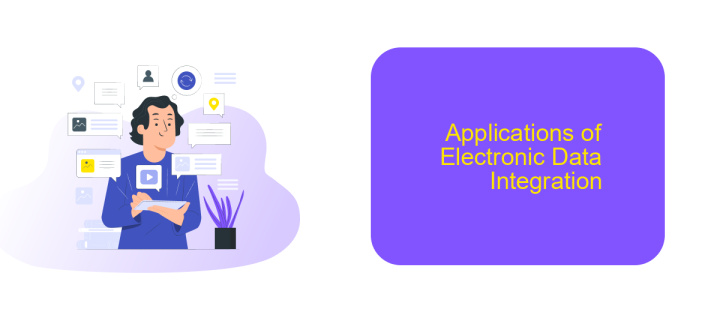Electronic Data Integration
Electronic Data Integration (EDI) is revolutionizing the way businesses manage and exchange information. By seamlessly connecting disparate systems and automating data transfer, EDI enhances efficiency, reduces errors, and accelerates decision-making processes. This article explores the benefits, challenges, and best practices of implementing EDI in modern enterprises, providing insights into how organizations can leverage this technology to stay competitive in an increasingly digital world.
Introduction
Electronic Data Integration (EDI) has become a cornerstone for modern businesses aiming to streamline their operations and enhance collaboration. By enabling seamless data exchange between disparate systems, EDI reduces manual processing and minimizes errors, thus improving overall efficiency.
- Automates data exchange processes
- Reduces human errors and manual intervention
- Enhances data accuracy and consistency
- Facilitates real-time information sharing
- Supports compliance with industry standards
One of the effective tools for setting up these integrations is ApiX-Drive. This service simplifies the process of connecting different applications and automating workflows, allowing businesses to focus on their core activities. By leveraging such platforms, companies can achieve smoother data integration and better interoperability across their digital ecosystem.
Data Integration Architecture and Components

Data integration architecture encompasses several critical components that work in harmony to ensure seamless data flow between disparate systems. Key elements include data sources, ETL (Extract, Transform, Load) processes, data storage, and data consumers. Data sources can range from databases and APIs to flat files and cloud storage. The ETL process extracts data from these sources, transforms it into a consistent format, and loads it into a central repository, such as a data warehouse. This repository then serves as the single source of truth for data consumers, which can be analytics tools, business applications, or end-users.
One of the essential services that facilitate data integration is ApiX-Drive. ApiX-Drive simplifies the process by providing a user-friendly interface to connect various applications and automate data transfer. It supports numerous integrations out-of-the-box, reducing the need for custom coding and manual intervention. By leveraging ApiX-Drive, organizations can streamline their data workflows, ensure data accuracy, and enhance operational efficiency. This service is particularly beneficial for businesses looking to quickly adapt to changing data integration needs without extensive technical expertise.
Benefits and Challenges of Electronic Data Integration

Electronic Data Integration (EDI) offers numerous benefits, including improved efficiency, reduced errors, and enhanced data accuracy. By automating data exchange between systems, EDI helps businesses save time and resources, allowing them to focus on core operations. Moreover, EDI facilitates real-time data sharing, which is crucial for making informed decisions and maintaining competitive advantage.
However, implementing EDI comes with its own set of challenges:
- Initial setup costs and complexity
- Data security and privacy concerns
- Compatibility issues between different systems
- Ongoing maintenance and updates
- Training employees to use new systems
To address these challenges, businesses can utilize services like ApiX-Drive, which simplifies the integration process by providing a user-friendly platform for connecting various applications. ApiX-Drive helps reduce setup complexity and ensures compatibility between different systems, making it easier for businesses to reap the benefits of EDI without being bogged down by technical difficulties.
Applications of Electronic Data Integration

Electronic data integration (EDI) has revolutionized the way businesses operate by enabling seamless data exchange between different systems and organizations. This technology facilitates real-time data transfer, reducing manual errors and increasing efficiency.
One of the primary applications of EDI is in supply chain management, where it helps streamline processes such as order processing, inventory management, and shipping. By integrating data across various stakeholders, businesses can ensure timely deliveries and improve customer satisfaction.
- Healthcare: EDI allows for the secure exchange of patient records, billing information, and insurance claims, enhancing the accuracy and speed of medical services.
- Finance: Financial institutions use EDI for transactions like invoicing, payment processing, and reporting, ensuring compliance and reducing operational costs.
- Retail: Retailers leverage EDI to manage product catalogs, track sales, and coordinate with suppliers, optimizing inventory levels and sales strategies.
Services like ApiX-Drive play a crucial role in facilitating electronic data integration by providing tools to automate and customize data flows between various applications. This ensures that businesses can easily set up and maintain their integrations without extensive technical expertise, making EDI accessible to a wider range of companies.
- Automate the work of an online store or landing
- Empower through integration
- Don't spend money on programmers and integrators
- Save time by automating routine tasks
Future of Electronic Data Integration
The future of electronic data integration is poised to be transformative, driven by advancements in artificial intelligence and machine learning. These technologies will enable more efficient and accurate data processing, reducing the time and effort required for manual data entry and validation. With the increasing adoption of cloud-based solutions, organizations will benefit from seamless data integration across multiple platforms, enhancing their ability to make data-driven decisions in real-time.
Services like ApiX-Drive are at the forefront of this evolution, providing user-friendly tools to automate data integration processes. ApiX-Drive offers a robust platform that simplifies the connection between various applications and services, ensuring that data flows smoothly and securely. As businesses continue to embrace digital transformation, the demand for such intuitive and reliable integration solutions will only grow, paving the way for a more connected and efficient digital ecosystem.
FAQ
What is Electronic Data Integration (EDI)?
Why is EDI important for businesses?
How does EDI work?
What are the common challenges in implementing EDI?
Are there tools to simplify EDI implementation?
Routine tasks take a lot of time from employees? Do they burn out, do not have enough working day for the main duties and important things? Do you understand that the only way out of this situation in modern realities is automation? Try Apix-Drive for free and make sure that the online connector in 5 minutes of setting up integration will remove a significant part of the routine from your life and free up time for you and your employees.


